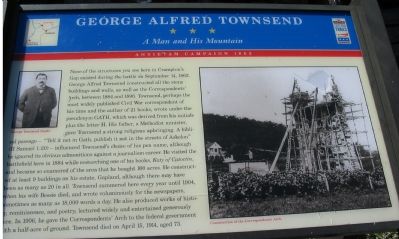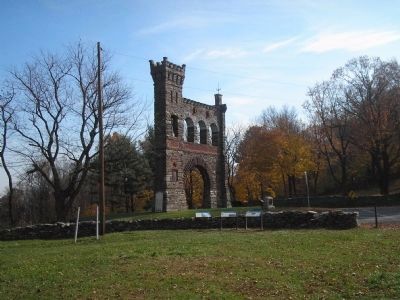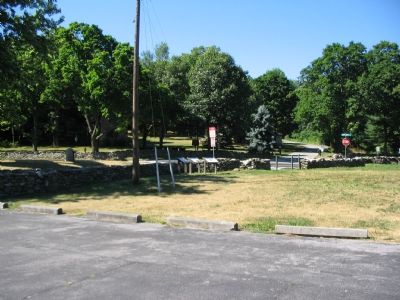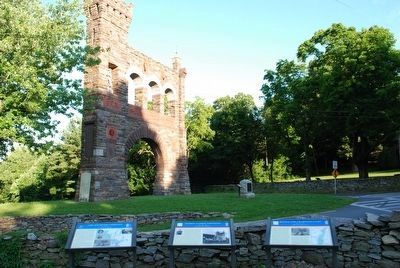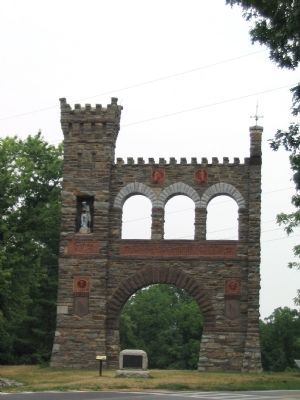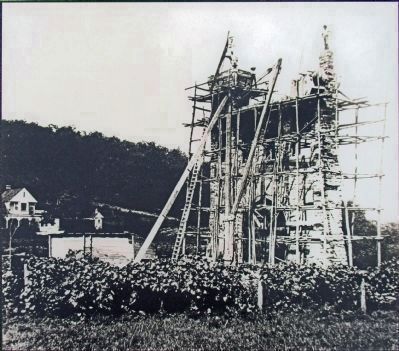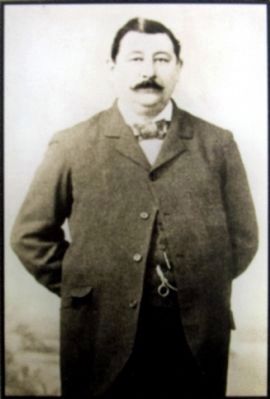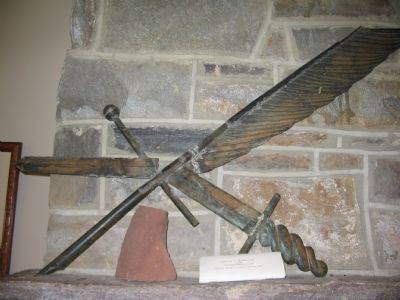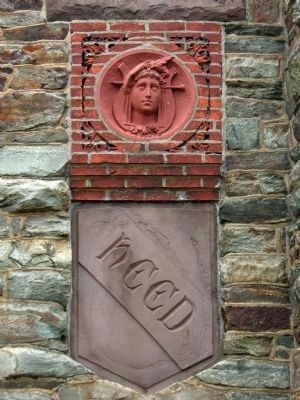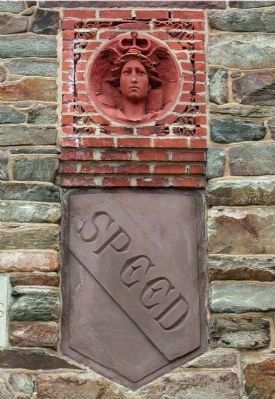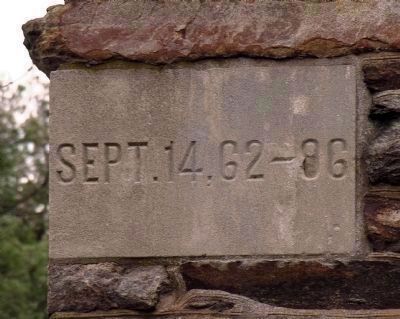Burkittsville in Frederick County, Maryland — The American Northeast (Mid-Atlantic)
George Alfred Townsend
A Man and His Mountain
— Antietam Campaign 1862 —
None of the structures you see here in Crampton’s Gap existed during the battle on September 14, 1862. George Alfred Townsend constructed all the stone buildings and walls, as well as the Correspondents’ Arch, between 1884 and 1896. Townsend, perhaps the most widely published Civil War correspondent of his time and the author of 21 books, wrote under the pseudonym GATH, which was derived from his initials plus the letter H. His father, a Methodist minister, gave Townsend a strong religious upbringing. A biblical passage—“Tell it not in Gath, publish it not in the streets of Askelon” (II Samuel 1:20)—influenced Townsend’s choice of his pen name, although he ignored its obvious admonitions against a journalism career. He visited the battlefield here in 1884 while researching one of his books, Katy of Catoctin, and became so enamored of the area that he bought 100 acres. He constructed at least 9 buildings on his estate, Gapland, although there may have been as many as 20 in all. Townsend summered here every year until 1904, when his wife Bessie died, and wrote voluminously for the newspapers, sometimes as many as 18,000 words a day. He also produced works of history, reminiscence, and poetry, lectured widely and entertained generously here. In 1906, he gave the Correspondents’ Arch to the federal government with a half-acre of ground. Townsend died on April 15, 1914, aged 73.
Erected by Maryland Civil War Trails.
Topics and series. This historical marker is listed in these topic lists: Notable Buildings • War, US Civil. In addition, it is included in the Maryland Civil War Trails series list. A significant historical date for this entry is April 15, 1914.
Location. 39° 24.353′ N, 77° 38.37′ W. Marker is in Burkittsville, Maryland, in Frederick County. Marker is at the intersection of Gapland Road and Arnoldstown Road, on the right when traveling west on Gapland Road. On the grounds of Gathland State Park. Touch for map. Marker is in this post office area: Burkittsville MD 21718, United States of America. Touch for directions.
Other nearby markers. At least 10 other markers are within walking distance of this marker. 1862 Antietam Campaign (here, next to this marker); Battle for Crampton’s Gap (here, next to this marker); War Correspondents Memorial Arch (a few steps from this marker); First New Jersey Brigade (within shouting distance of this marker); War Correspondents (within shouting distance of this marker); Crampton’s Pass Tablet C.P. 1 (within shouting distance of this marker); Maj. Gen. Lafayette McLaws' Command (within shouting distance of this marker); Crampton’s Pass Tablet C.P. 3 (within shouting distance of this marker); Sixth Army Corps (within shouting distance of this marker); Maryland Campaign of 1862 / The Lost Orders (within shouting distance of this marker). Touch for a list and map of all markers in Burkittsville.
More about this marker. The
marker features a portrait of George Alfred “GATH” Townsend and a photograph of the arch while under construction.
Related markers. Click here for a list of markers that are related to this marker.
Also see . . .
1. National War Correspondents Memorial. Wikipedia entry (Submitted on February 28, 2022, by Larry Gertner of New York, New York.)
2. War Correspondents Memorial Arch, (sculpture). This entry in the Smithsonian Institution catalog of outdoor art describes the arch in detail and gives additional interesting and historical information. (Submitted on August 1, 2007, by J. J. Prats of Powell, Ohio.)
3. Recent Additions to the Park have Prompted Some Discussion. History News Network website entry:
In 2003 a small plaque memorializing journalists who died covering the War on Terror was added to the park. (Submitted on July 29, 2007, by Craig Swain of Leesburg, Virginia.)
4. Katy of Catoctin or, the chain-breakers ; a national romance. Internet Archive website entry (Submitted on February 28, 2022, by Larry Gertner of New York, New York.)
Additional commentary.
1. Gathland State Park
The arch is technically on National Park Service land, but surrounded by Gathland State Park. The park preserves the existing buildings erected by Townsend and the ruins of others.
— Submitted July 29, 2007, by Craig Swain of Leesburg, Virginia.
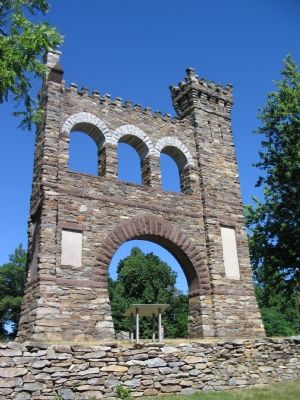
Photographed By Craig Swain, July 21, 2007
5. The War Correnspondent's Arch
The stone tablets on either side of the memorial list war correspondents from the Civil War who wrote for both Northern and Southern newspapers. The list includes artists as well as writers. The three upper tier arches symbolize description, depiction, and photography. On the opposite side, faces depict "electricity" and "poetry" with the words "speed" and "heed".
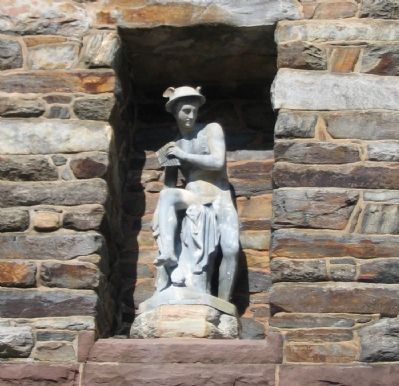
Photographed By Craig Swain, July 21, 2007
9. Pheidippides Statue in the Memorial
This statue, on the south side of the arch, depicting Pheidippides who brought news of the Greek victory at Marathon, symbolizes the correspondent. He is sheathing a sword, wearing Mercury's helmet, and using the pipes of Pan.
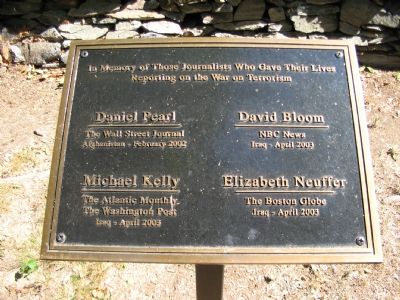
Photographed By Craig Swain, July 21, 2007
10. Recently Added Plaque in Memory to Journalists Lost in the War on Terror
“In Memory of Those Journalists Who Gave Their Lives Reporting on the War on Terrorism. Daniel Pearl, The Wall Street Journal, Afghanistan – February 2002. David Bloom, NBC News, Iraq – April 2003. Michael Kelly, The Atlantic Monthly, The Washington Post, Iraq – April 2003. Elizabeth Neuffer, The Boston Globe, Iraq – April 2003.”
Credits. This page was last revised on February 28, 2022. It was originally submitted on July 29, 2007, by Craig Swain of Leesburg, Virginia. This page has been viewed 3,131 times since then and 31 times this year. Photos: 1. submitted on July 29, 2007, by Craig Swain of Leesburg, Virginia. 2. submitted on January 9, 2014, by Bill Coughlin of Woodland Park, New Jersey. 3. submitted on July 29, 2007, by Craig Swain of Leesburg, Virginia. 4. submitted on August 9, 2015, by Brandon Fletcher of Chattanooga, Tennessee. 5. submitted on July 29, 2007, by Craig Swain of Leesburg, Virginia. 6. submitted on August 5, 2007, by Craig Swain of Leesburg, Virginia. 7, 8. submitted on May 8, 2013, by Allen C. Browne of Silver Spring, Maryland. 9, 10. submitted on July 29, 2007, by Craig Swain of Leesburg, Virginia. 11. submitted on August 13, 2007, by Craig Swain of Leesburg, Virginia. 12, 13, 14. submitted on May 9, 2013, by Allen C. Browne of Silver Spring, Maryland. • J. J. Prats was the editor who published this page.
